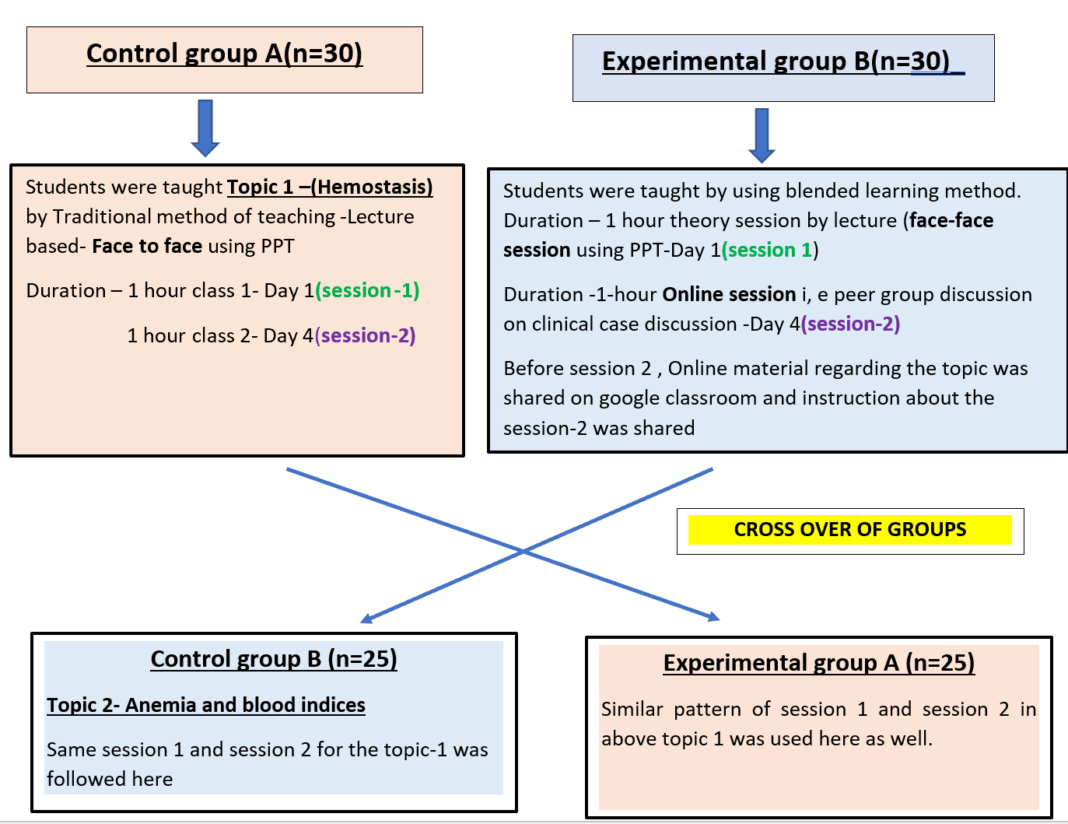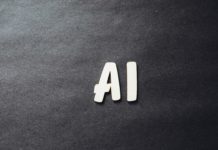Incorporating technology with traditional face-to-face teaching: A blended learning approach for medical students.
Dr Ayesha Juhi
Associate Professor, Department of Physiology,
All India Institute of Medical science ,Deoghar
Abstract
Background: The current study was aimed to understand the effectiveness of blended learning in comparison to the traditional class room teaching among medical students. Additionally, also to understand how the students felt about the two different approaches of teaching learning methods.
Method: This was a cross over randomised control study. The subjects were divided into control and experimental groups. Selected topics with high clinical importance were taught using both traditional and blended learning technique to 1 MBBS students. The post-test scores before and after the teaching sessions were compared in both the type of teaching learning methods. The student’s perception about the two different methods were collected using a pre-validated questionnaire.
Results: The scores of the post-test were significantly higher with the blended learning when compared to the post test score with Traditional teaching learning method (p<0.001). Also, the questionnaire used to study the perceptions about the blended learning showed 95% students believing that blended learning aids in the reinforcement and concept building processes, as well as in revising concepts at their own pace and accessibility.
Conclusion: The current study found that incorporating blended learning has a positive impact on student performance. Additionally, the study found that blended learning was more acceptable to students, indicating the importance of incorporating blended learning into medical curriculum in India on a larger scale.
Keyword: blended learning, traditional, class room teaching, students
Research Article
The Pandemic forced us to become acquainted with and use virtual technologies for teaching, as well as expand the range of possible new ways of educating learners. Reading, writing, and memorization of information are no longer the only components of education. In the present era, medical education has now evolved from a teacher-centered to a student-centered approach of training, in which students become the active learners and teachers have shifted to a facilitator role that facilitates student learning.
Traditional lecture-based teaching methods assumes that all students learn at the same pace and are at the same level of understanding.
The lecture has traditionally been the most common teaching method in medical education. A lecture has the advantage of transferring information from medical educators to a large number of students at once, and it is a simple and effective method of conveying factual information (1).Didactic lectures are perceived by the students as the least effective method (2).
Blended learning (also known as hybrid learning) is a teaching method that combines technology and digital media with traditional instructor-led classroom activities, allowing students to have more flexibility to tailor their learning experiences. Presently, as evidenced by the rapid adoption of technology-assisted teaching methods and blended learning models, innovative educators in both higher education and corporate learning and development are improving learning through technology. Blended learning is gaining popularity in medical education, owing to its feasibility in terms of time constraint, cost savings, reducing the need for space and faculty/facilitators.The effectiveness of online teaching is still controversial. (3,4). As a result, when traditional lectures are limited, blended learning is critical for medical students.
There is limited research available on the appropriate use of technology-enhanced learning environments as part of a blended approach to the medical education.
The present study was taken with an objective to evaluate the effectiveness of Blended technique in comparison to traditional teaching learning method using pre-test and post-test scores among 1 MBBS students. And also, to assess the perceptions of the students towards blended learning in comparison to traditional teaching learning methods among students using a pre-validated questionnaire.
Material and methods
The study was conducted on Phase 1 MBBS students. The study design is cross over randomized controlled study. In which the students were divided randomly into 2 groups. For the topic -1 Group A was a control group and Group B was an experimental group. For the topic -2, Group A became the experimental group and Group B became the control group. The ethical clearance for carrying out the study and informed consent from the students was taken.
Before conducting the topics by both the different methods the pre-test was conducting to assess the level of knowledge of the students. After implementing the sessions post test was taken again to compare the level of knowledge gained among them
The details of the two different methods, how they have been carried out is explained in the above flow chart. The pretest scores of the Group A and Group B had no statistically significance using unpaired t test. The scores of the post test were calculated and statistically compared using unpaired t test.

The results of Post test scores between the Group A and Group B for the Topic -1 (Total marks of the test conducted =30)
| Method | Post test score (n=30) Mean ±SD | P Value |
| Traditional learning (Group-A) | 16±1.77 | <0.001 |
| Blended learning (Group-B) | 26±2.12 |
The results of Post test scores between the Group A and Group B for the Topic -2 (Total marks of the test conducted =30)
| Method | Post test score (n=25) Mean ±SD | P Value |
| Traditional learning (Group-B) | 14±1.09 | <0.001 |
| Blended learning (Group-A) | 26±0.12 |
This study also studied the perceptions of the students on blended learning versus traditional learning method using a revalidated questionnaire. (n=60)
| Disadvantages of blended learning | Disagree | Neither agree nor disagree | Agree |
| Extra effort by the student is required | 4 | 4 | 52 |
| It is boring | 48 | 7 | 5 |
| Time consuming | 30 | 5 | 25 |
| Extra effort required by the teacher to conduct online teaching apart from traditional teaching | 0 | 2 | 58 |
| If internet issues exists then online session can’t be attended. | 0 | 2 | 58 |
| It is purely based on the interest of the student | 46 | 9 | 5 |
| Not a good method to develop a clinical skill | 45 | 6 | 9 |
| Not all students get equal chance to respond with peers and faculty/facilitator | 50 | 7 | 3 |
| Not an ideal method to learn communication skills | 2 | 8 | 50 |
| There is no difference between traditional learning and blended learning method. | 58 | 2 | 0 |
| I find traditional learning method is an ideal way to learn | 52 | 5 | 3 |
Results
In the graphical presentation above shows that the post test scores with blended learning was significantly higher p<0.001 when compared to traditional learning methods in both the topic 1 and 2 .The perceptions showed that 95% of the student believed blended learning is useful in concept building, reinforcement of the topic at their own space. It also builds communication skills between peer groups and faculty. But they also felt it requires an extra effort by both the student and faculty to carry out blended learning .
Discussion
Researchers from all over the world are focusing on interactive methods that are effective in teaching medical students.
Our findings suggest that medical students and teachers are open to new methods and interactive blended learning, and that being tech savvy is a 21st-century skill that the modern digital generation cannot live without.. That is why blended learning is an effective method and a great decision of combination of online learning and face-to-face learning for modern life
Students can practise their medical knowledge at their own pace and receive immediate feedback. Furthermore, blended learning actively involves them in the learning process. This type of method provides students with several advantages such as the opportunity to analyze, synthesize, and evaluate ideas, it can be concluded that blended learning fosters the development of critical thinking and self-directed learning skills. A teacher’s role shifts to that of a facilitator, who creates a meaningful learning experience and motivates students through problem-solving tasks. It also should be accepted that blended learning requires an extra effort and time for implementing blended learning and the both teacher and student should be tech savvy.
Conclusion
When compared to traditional classroom teaching, blended learning has a greater impact on student performance. Additionally,the study found that blended learning was more acceptable to students, indicating the importance of incorporating blended learning into medical curriculum in India on a larger scale.
References
- M. Wolff, M.J. Wagner, S. Poznanski, J. Schiller, S. Santen Not another boring lecture: engaging learners with active learning techniques J. Emerg. Med., 48 (1) (2015), pp. 85-93
- N.A., Musa, O.A. & Saeed, A.M. Comparison of the effectiveness of lectures based on problems and traditional lectures in physiology teaching in Sudan. BMC Med Educ 19, 365 (2019).
- S.J. Bartley, J.H. Golek. Evaluating the cost effectiveness of online and face-to-face instruction.Educ. Technol. Soc., 7 (4) (2004), pp. 167-175
- L. Pei, H. Wu. Does online learning work better than offline learning in undergraduate medical education? A systematic review and meta-analysis Med. Educ. Online, 24 (1) (2019).








